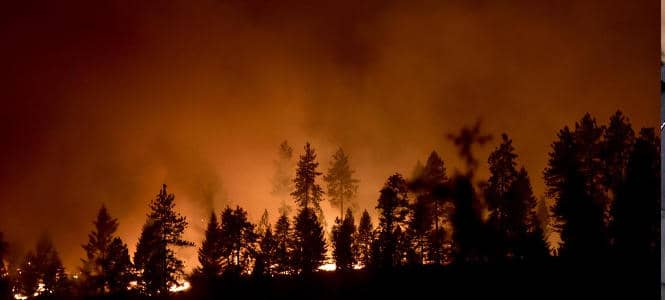

Under California Penal Code 451 PC, the legal definition of arson consists of the following elements of the crime:
It is important to note that anyone who aids, counsels, or procures the burning of or the intent to burn anything can also be tried for arson.
In order to understand arson, it is important to recognize what the terms stated in the definition really mean here:
To act “willfully” is to commit an act willingly or on purpose, regardless of whether or not you knew what you were doing.
To act “maliciously” means to intentionally commit a wrongful act while wishing to vex, defraud, annoy, or injure another person.
When you damage or destroy something with fire, you can be charged for Arson CA Penal Code 451, 452. Whether it is an entire building or a small door in the building, anything that is set on fire counts as being destroyed by fire.
A “structure” is any building, commercial or public, as well as tents, bridges, tunnels, or power plants.
“Forest Land” means any brush-covered land, cut-over land, forest land, grasslands, or woods.
“Property” can either be real property or personal property that is not a structure or forest land, such as furniture, cars, boats, clothing.
In the state of California, arson can be categorized into varying specific types of arson California Penal Code 451, 452 crimes.
Under CA PC 451, a person can only be found guilty of “malicious arson” if the prosecutor can prove the following:
If the suspect did not have this intent, then he/she may be charged instead with—or may be able to plea bargain down to—“reckless arson.”
Example: Diego is constantly bullied at school. Out of anger and resentment, he decides to burn down his high school building at night (after everyone has left). He sets the fire, but due to his lack of experience in sustaining fires, it eventually dies and the only piece of property that is damaged by the time the fire goes out is the carpet in a small classroom.
It is clear that Diego has committed arson—malicious arson, to be exact—even though most of the entire school property is still perfectly intact and undamaged.
“Aggravated Arson” is an additional allegation to the crime of arson. Under CA PC 451.5, any person who commits arson deliberately, with premeditation, and with the intent to cause injury to someone else or the intent to cause damage to property in order to injure another person is guilty of aggravated arson if any of the following aggravating factors exists:
This type of arson occurs when someone unlawfully, or “recklessly”, sets fire to a structure, forest-land, or property. For the purposes of PC 452, acting “recklessly” means:
It is important to note that acting “recklessly” is not equivalent to acting carelessly or negligently. Thus, accidents do happen, and that’s okay as that doesn’t make a person guilty of recklessness. But behaving with a complete disregard for safety may constitute recklessness.
Example: You throw a lit cigarette into a bush and it consequently catches on fire. You are well aware that you A) shouldn’t have littered, and B) shouldn’t have tossed a burning cigarette anywhere without putting it out first.
In California, each type of arson has its own set of consequences, depending on factors such as:
Willful or malicious arson is always a felony under California law. Depending on where the arson was committed, the potential prison terms for this felony include:
In addition to the prison sentencing, an arson felon may face further punishment of up to $50,000 in fines if the crime was not committed for any pecuniary gain. If the prosecutor is able to prove that financial gain was either a motive or actually distributed to the felon, then twice the amount of the actual or anticipated gain may be charged against the defendant.
Lastly, a malicious arson conviction is deemed a “strike” on one’s criminal record under California’s Three Strikes Law.
Considered as a “wobbler,” reckless arson can be charged as either a misdemeanor or a felony depending on the circumstances. The potential sentences for the different types of reckless arson are:
Under California law, an arsonist faces an additional and consecutive sentence of one, two, or three-years in state prison if any of the following circumstances exist:
However, if the prosecutor can prove that you committed arson
Then you face a state prison sentence of ten years to life.
Furthermore, there are other circumstantial “aggravating factors” that can determine a prolonged sentence, such as arson being expressed in the form of a “hate crime.”
Example: You set fire to your apartment because your landlord is evicting you. Or you set fire to a religiously affiliated structure of worship out of hate.
In addition to the corresponding penalties, anyone who is convicted of
in the state of California will be required to register as a California convicted arson offender.
Thus, similar to an individual registered as a sex offender, the convicted arsonist must routinely update his/her local law enforcement agency regarding his/her whereabouts.
Since November 30, 1994, those who are convicted as adults will be registered for life. However, the duration for registration may also depend on the age of the arsonist at the time of the conviction as well as the date.
There are separate misdemeanor offenses of an arsonist failing to properly register that may lead to a jail sentence of over 90 days and up to 1 year.
An experienced attorney should present the most appropriate defenses to any arson crime charge for you due to the strict and severe penalties that may result. In any case, there are several different ways one can alleviate such offenses.
If you can prove that the fire was unintentional and the result of an accident, then you cannot be found guilty of arson. In order for the prosecution to convict you of arson or reckless burning, they must prove that you acted maliciously or recklessly.
If someone else committed the arson and you were blamed, or if eyewitnesses have mistakenly named you as the culprit of another person’s arson actions, then you can make the claim that you weren’t behind the arson. Or if law enforcement arrests you without a probable cause for arrest, then you can make the claim that there was an unlawful arrest.
Due to the nature of the process of arson, most prosecutors understand that arson can only reasonably be committed by deliberate preparation, oftentimes involving the use of some fire-starting device. This “circumstantial evidence” is necessary to build proof against the defendant, and without much circumstantial evidence, it would be difficult for the prosecutor to make his/her case.
As stated before, arson requires a very specific plan of action and must be thoroughly investigated to determine whether or not the fire was indeed started by arson. As special forensic units are responsible for finding conclusions, they may not always be right in their findings.
If you or a loved one is being charged with Arson California Penal Code 451, 452, we invite you to contact us immediately for a free case review. Schedule an appointment to meet with us in person, or feel free to submit an evaluation online and we will get in contact with you ASAP. We can provide a free consultation in our office, or by phone. Our experienced and assiduous Criminal Defense Lawyers will be sure to fight until the end to reduce or drop your charges completely.
Call LAW MART for a FREE Case Review: 310-894-6440

Copyright © 2024 law – Powered by AmelCS